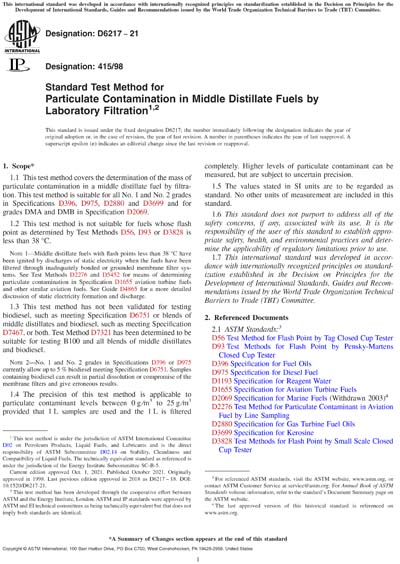Most recent
ASTM D6217-21
Standard Test Method for Particulate Contamination in Middle Distillate Fuels by Laboratory Filtration
1.1This test method covers the determination of the mass of particulate contamination in a middle distillate fuel by filtration. This test method is suitable for all No. 1 and No. 2 grades in Specifications D396, D975, D2880 and D3699 and for grades DMA and DMB in Specification D2069.
1.2This test method is not suitable for fuels whose flash point as determined by Test Methods D56, D93 or D3828 is less than 38 °C.
Note 1:Middle distillate fuels with flash points less than 38 °C have been ignited by discharges of static electricity when the fuels have been filtered through inadequately bonded or grounded membrane filter systems. See Test Methods D2276 and D5452 for means of determining particulate contamination in Specification D1655 aviation turbine fuels and other similar aviation fuels. See Guide D4865 for a more detailed discussion of static electricity formation and discharge.
1.3This test method has not been validated for testing biodiesel, such as meeting Specification D6751 or blends of middle distillates and biodiesel, such as meeting Specification D7467, or both. Test Method D7321 has been determined to be suitable for testing B100 and all blends of middle distillates and biodiesel.
Note 2:No. 1 and No. 2 grades in Specifications D396 or D975 currently allow up to 5 % biodiesel meeting Specification D6751. Samples containing biodiesel can result in partial dissolution or compromise of the membrane filters and give erroneous results.
1.4The precision of this test method is applicable to particulate contaminant levels between 0 g/m3 to 25 g/m3 provided that 1 L samples are used and the 1 L is filtered completely. Higher levels of particulate contaminant can be measured, but are subject to uncertain precision.
1.5The values stated in SI units are to be regarded as standard. No other units of measurement are included in this standard.
1.6This standard does not purport to address all of the safety concerns, if any, associated with its use. It is the responsibility of the user of this standard to establish appropriate safety, health, and environmental practices and determine the applicability of regulatory limitations prior to use.
1.7This international standard was developed in accordance with internationally recognized principles on standardization established in the Decision on Principles for the Development of International Standards, Guides and Recommendations issued by the World Trade Organization Technical Barriers to Trade (TBT) Committee.
Content Provider
ASTM International [astm]






